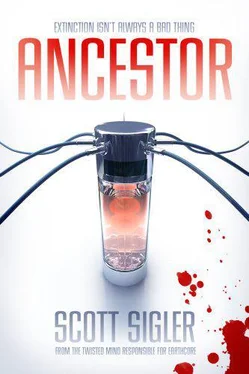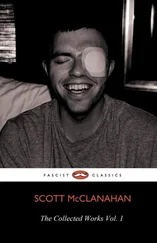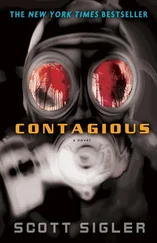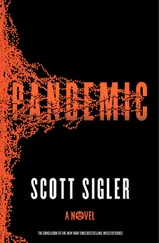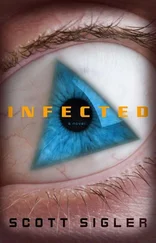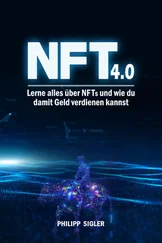He turned and walked out of the room. She rubbed her eyes. She was tired. But it wouldn’t take that long to finish this process.
They’d long ago collected samples of every living mammal known to man. After that, Danté had started acquiring samples from extinct species. Each time they digitized one of those additional genomes, the God Machine’s viability rate went up. Would the four new samples Bobby had delivered take them over 80 percent?
The myriad forms of animals on Earth take many shapes, but every last one is made from a simple set of four nucleotides: adenine, guanine, cytosine and thymine . Those four basic nucleotides create the double helix structure that is deoxyribonucleic acid, or DNA. Some people didn’t understand double helix , but everyone got Jian’s favorite description—the twisting ladder.
Variety between the strands, across the rungs of the DNA ladder, is limited even further, to just two combinations: adenine can only bind with thymine, and guanine can only bond with cytosine. But the combinations along the sides of the ladder, the four letters A, G, T and C , combine in infinite ways.
Those infinite combinations were what Jian wanted to analyze, to digitize, so the God Machine could see the full genome of each animal and compare it with the master ancestor sequence.
First, she extracted the cellular DNA of the four extinct mammals and placed each in a vial. To each vial, she added her sequencing master mix. The mix consisted of a DNA polymerase, random primers and the four basic nucleotides. The mix also included dideoxynucleotides, which were nucleotides with a slightly different chemical structure that contained a fluorescent section critical to the final stage of the process.
She slid the vials into a polymerase chain reactor, a machine designed to produce billions of copies of the target DNA. First the PCR machine “unzipped” the DNA by heating it to ninety-five degrees Celsius, which broke the hydrogen bonds in the rungs. That split the double helix, leaving two single strands of DNA. The machine then cooled the mixture to fifty-five degrees Celsius. This brought the prefabricated random primers into play. A primer is to a strand of DNA what a foundation is to a brick wall: DNA strands can’t form at random, they have to begin with a primer. Lowering the temperature allowed the primers to lock in to complementary sections on the single DNA strand, so that a primer with the combination ACTGA would make rungs that created a combination of TGACT on the other side of the ladder. A binds with C, T binds with G , and click, a starting point locks down.
Then, more heat.
As the temperature rose to seventy-two Celsius, the DNA polymerase started at the random primers and moved down the open strand, locking free nucleotides onto the open-ended single DNA strands—just like a train engine building the track underneath it as it goes. The end result was two perfect copies of the original DNA strand. From there, the process quickly repeated over and over—two copies became four, then eight, then sixteen, an exponential increase that added up fast.
In years past, there had been more steps she had to follow, but now the entire process was automated. Her machine created millions of identical copies, peppered with the little fluorescent dideoxynucleotide chunks that marked segments. The computer used a laser to make those chunks fluoresce, then counted off the segments. End result? A nucleotide-by-nucleotide analysis of the animal’s DNA. The millions of copies provided an extremely high degree of accuracy.
The resultant data fed automatically into the supercomputer known as the God Machine. There, Jian’s programming would take over. She closed the lid on the PCR machines and set them to run automatically.
In just a few hours, the four new DNA sequences would join the thousands they had already sequenced. She called up the current genome database.
GENOME A17 SEQUENCING: PROCESSING
PROOFREADING ALGORITHM: PROCESSING
PROJECTED VIABILITY PROBABILITY: 65.0567%
Over and over again the powerful God Machine processed trillions of combinations of DNA, looking for the magical set that would produce a viable embryo. They were close now. A few more samples, a few more mammalian species, perhaps, and they would have it.
She still had her secret experiment, the one she hadn’t revealed to Rhumkorrf. Colding had insisted on destroying all elements of the human surrogate mother program. Jian had saved just a little bit. A special little bit. She had an ancestor genome with 99.65 percent viability probability, one that would beat the immune response for sure.
Not a cow’s immune response… her immune response.
That had been her little secret through the human surrogate phase. She’d used her own DNA as the primary working template. The irony was that Colding’s insistence on eliminating the human surrogates had saved the company, but if they could use a human surrogate, they would have successful implantation on the first try. Jian had kept her own modified eggs, hiding them inside the waist-high tank of liquid nitrogen that also held the last sixteen rounds of God Machine genomes. They were her eggs, after all, and she couldn’t really bear to part with them.
Maybe, if the bovine experiments totally failed, she’d actually use them. Millions of lives hung in the balance. Rhumkorrf would probably even help. He was desperate to make it happen, desperate to make Jian stop being so stupid , such a failure .
So many people. People dying every day, dying because of her incompetence.
She needed to relax. Maybe Tim was right… maybe a little video game. Just for a few minutes. No one would know if she stopped working. Jian quietly turned to her left-lower monitor and called up the Chess Master program. So bad to play now! But she was stumped. Come on, Kasparov level, do your best.
She always beat the Kasparov level. At least the computer program was good enough to make her actually think about her moves, which was more than she could say of playing anyone else in the project. Poor P. J., always trying so hard to win, but he could only see five or six moves into the future. Jian saw entire games played out before the first pawn advanced.
She stared at the black-and-white pieces lined up neatly on the video chessboard. The computer waited for her to make the first move, but for some reason she could only stare at the pieces. The black pieces. The white pieces. Black and white.
Black and white.
Black and white.
They might be another color, and yet the game would still be the same. Blue and red, yellow and purple, and that wouldn’t make any difference because the board’s function didn’t change.
The board that lay underneath the black-and-white pieces. Black and white…
… like the fur on the cows.
“That’s it,” she whispered. “That’s it!”
She quit the chess program and called up the bovine genome, her fingers an unrecognizable blur on the keyboard. It was so obvious. Why hadn’t she thought of this before? If all that mattered was the internal organs, the underneath , she could eliminate hundreds of potentially problematic genes by swapping out what was on top— the integument.
The God Machine could process that change even while counting off the genomes of the four extinct mammals. Could all of it be enough to push the viability rating over 80 percent?
Her main terminal let out an alarm beep, demanding her attention. She called up the alarm window.
REMOTE BACKUP FAILURE
The off-site backup, the ten-petabyte data drive array that sat in a temperature-controlled brick building at the end of the runway… it had failed. That system hadn’t failed once in the fourteen months since they’d installed it. The array was designed to survive no matter what, to keep the experiment alive in the event of worst-case scenarios at the main facility. Computer crashes, fire, electromagnetic pulses… she’d been told it could even survive a really big explosive called a fuel-bomb , although she couldn’t imagine why someone would use such a destructive thing on a harmless research facility.
Читать дальше
